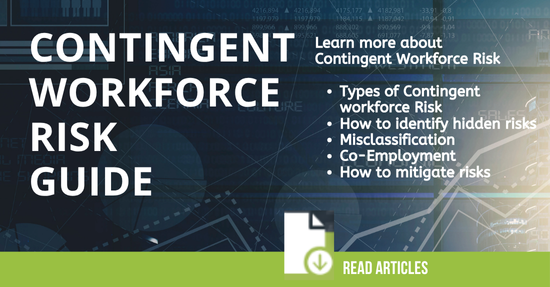Employers are turning to the contingent workforce to access benefits such as improved access to expertise, business flexibility, filling skills gaps, greater cost efficiencies and better access to talent. Yet, there can be hidden risks. In this article, we’re going to take a look at the most common hidden risks and what you can do about it.
Although a contingent workforce comes with many benefits for businesses - a poorly managed contingent workforce comes with a range of risks that impact the bottom line of your organization if left unchecked. That’s why contingent workforce management is crucial to a successful non-employee workforce.
When looking at risk, the most common hidden risks in a contingent workforce are those that have no real program, strategy or vendor management software to underpin it.
Hidden Risks associated with a contingent workforce
More companies than ever before are relying on nontraditional workers to access hot skills and beat the skills shortage, but the vast majority of these companies aren’t ready to manage the hidden risks that come with it.
That’s because managing a contingent workforce is complex. It involves a huge number of workers, vendors (staffing agencies) and data points across every department within your organization.
To be successful, contingent workforce management needs to be a centralized, company-wide initiative, in which hiring managers are all using the same staffing agencies, at the same rates and following standardized rules for hiring non-employee workers.
If this isn’t followed, hidden risks will run through your organization and your business will have absolutely no visibility or control over them.
Here are some of the most common hidden risks associated with the contingent workforce:
1 - No visibility into staffing vendor performance
With no real contingent workforce program in place, it’s virtually impossible to standardize vendor analysis and rates across your organization. When you have a decentralized approach to sourcing, engaging and managing your staffing agencies, your business will have absolutely no visibility or control over how your vendors are performing.
How to Solve this: To improve this process, it’s crucial that your business consolidates all vendors and transactions into one centralized location through the use of a vendor management system (VMS). You’ll have access to the KPIs, data and metrics that show how your vendors are performing.
2 - Rogue spend
Financial risk can come from a number of places within your contingent workforce, but it typically goes unnoticed when an organization has no centralized management strategy for their staffing agencies and contingent workers.
How to Solve This: To avoid Rogue spend, you need to improve the visibility and consistency in how you manage your staffing vendors, ensure complete transparency into how much money you are actually spending on nontraditional workers and ensure standardization of contingent worker rates to avoid your business overpaying for talent. A VMS can help you reduce Rogue Spend by consolidating your vendors and manage every step of your contingent workforce in one central database. A VMS will automate transactions, store non-employee workforce data, facilitate onboarding, measure vendor performance, collect requisitions from managers and consolidate all of your vendors in one location. You will have clear visibility into contingent workforce spend.
3 - Operational inefficiencies
Most organizations have fragmented contingent workforce management processes that lead to wasted time and human error. This is often the fault of using manual spreadsheets to manage your contingent workforce and staffing agencies.
How to Solve This: Finding a way to automate these processes, such as through the use of a VMS, you’ll be able to free up your employees from working on time-consuming, repetitive tasks and instead allow them to focus on the things that drive real value to your business.
4 - Worker misclassification
Non-employee worker misclassification happens when an organization incorrectly identifies the relationship that exists between their business and the contingent worker. To avoid hefty fines and penalties, it’s important that your organization classified its nontraditional workers correctly.
How to Solve This: While most countries and states have online tests that help ensure your business is properly classifying its contingent workers, a VMS gives you the platform you need to properly document, classify and define your relationship with nontraditional workers. Proper documentation of contingent workers will ensure your business doesn’t incorrectly identify the relationship between them and your organization.
Why Technology Is Key to Contingent Workforce Success
Manual processes and spreadsheets make contingent workforce programs inefficient and risky. A modern Vendor Management System (VMS) like Conexis VMS helps businesses:
-
Gain visibility and control over all contingent labor.
-
Standardize processes across staffing agencies.
-
Ensure compliance with labor and tax regulations.
-
Reduce costs while improving scalability.
Learn more about the benefits of a VMS
Learn more about the Benefits of a VMS. Download our Free VMS Buyer's Guide:
Learn More about Contingent Workforce Management
- Contingent Workforce Terms You Need to Know
- Contingent Workforce Management Guide
- Contingent Workforce Stats you need to know
- Contingent Workforce Best Practices
Discover how Conexis VMS can help you manage your Contingent Workforce
Conexis is an award-winning Vendor Management System built for organizations that want the power of enterprise software without the complexity or cost. Built on the latest technology, Conexis delivers the expertise, reliability and security of enterprise systems, while offering the flexibility, user friendliness and tailored, personal service you require. Learn more about our Company and why organizations Choose Conexis VMS.
Why Companies Choose Conexis VMS
Conexis VMS is purpose-built for organizations seeking to manage their contingent labor spend effectively. Here’s why we're the right choice:
- Fast Deployment: Get up and running in weeks, not months
- Transparent Pricing: Flexible pricing with no hidden costs
- White-Label Ready: Customize the platform with your brand
- Real-Time Insights: Make faster decisions with built-in analytics
- Audit-Ready Compliance: Store contracts, worker data, and rates in one secure hub
Looking to Switch Your VMS or Just Getting Started?
Whether you are looking to Switch your VMS, or just Getting Started, we are here to help. Contact Us for a Free No-Obligation Consultation, See how Easy Conexis is to use by taking a quick 2 minute Self-Guided Online Demo, or Book a Personal Demo Today!
Additional articles on the Managing Contingent Workforce Risk: Managing Risk Guide
- Co-Employment Risk: How a VMS Shields you from Risk
- Misclassification: A Critical Risk for Contingent Workforce Programs
- 10 Ways a VMS helps reduce Contingent Workforce Compliance
- How to Identify the Hidden Risks in Your Contingent Workforce Program
- How to Track Contingent Workforce Compliance Risk with a VMS
- What is Contingent Workforce Compliance Risk?
- Is your Staffing Agency putting your company at risk?
- The Benefits and Risks of Hiring Contingent Workers
- The Top 5 Contingent Workforce Risks and How to Manage them
- How a VMS keeps you compliant and audit-ready










